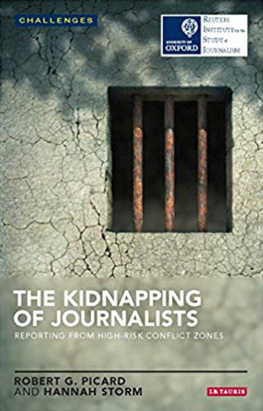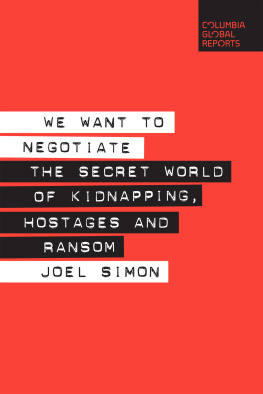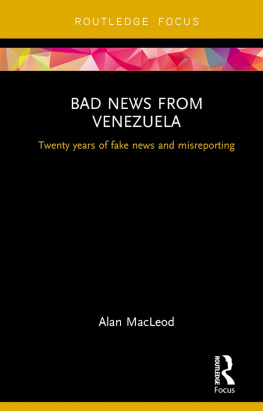THE KIDNAPPING OF JOURNALISTSRISJ CHALLENGES
CHALLENGES present findings, analysis, and recommendations from Oxfords Reuters Institute for the Study of Journalism. The Institute is dedicated to the rigorous, international comparative study of journalism, in all its forms and on all continents. CHALLENGES muster evidence and research to take forward an important argument, beyond the mere expression of opinions. Each text is carefully reviewed by an editorial committee, drawing where necessary on the advice of leading experts in the relevant fields. CHALLENGES remain, however, the work of authors writing in their individual capacities, not a collective expression of views from the Institute.
EDITORIAL COMMITTEE
Timothy Garton Ash
Ian Hargreaves
David Levy
Geert Linnebank
John Lloyd
Rasmus Kleis Nielsen
James Painter
Jean Seaton
Katrin Voltmer
The editorial advisers on this CHALLENGE were Richard Sambrook and Ian Hargreaves.
Robert G. Picard is North American Representative for the Reuters Institute in the Department of Politics and International Relations at the University of Oxford and a fellow of the Royal Society of Arts. He was formerly Director of Research at the Institute and a research fellow at Green Templeton College (Oxford). He is the author and editor of 30 books and has been editor of two leading journals. He received his PhD from the University of Missouri, Columbia, and has been a fellow at the Shorenstein Center at the John F. Kennedy School of Government at Harvard University. He has consulted and carried out assignments for governments in North America, Europe, Africa, and Asia and for international organisations including the European Commission, UNESCO, and the World Intellectual Property Organization. He has been a consultant for leading media companies in North America, Europe, Asia, Africa, and Latin America.
Hannah Storm is Director of the International News Safety Institute (INSI), which provides safety advice and training to journalists working in dangerous situations. Its members include the BBC, CNN, and Al Jazeera. Before joining the INSI in 2010, Storm spent more than a decade working as a journalist in television and radio, and online for outlets including the BBC, The Times, and ITN. She started her career as a graduate trainee at Reuters after reading English at Oxford University. She is the author of No Womans Land: On the Frontlines with Female Reporters, which explores the unique safety issues of women who work in the media. She also works as a freelance consultant for different UN agencies with a specific focus on gender and media.
The practice of journalism is increasingly dangerous and attacks on journalists continue unabated. A particularly troublesome feature of this violence is that a rising number of journalists are being kidnapped for ransom or held as hostages. This growing global problem threatens the practice of journalism and the ability of news media to fully inform the public about events occurring in the world.
Journalists and media workers are highly vulnerable to kidnappings because they often work in dangerous locations, seek access to adversaries involved in conflicts, and may have to rely on shadowy contacts and sources in carrying out their work. Just how vulnerable journalists are in kidnap scenarios was starkly illustrated by the executions of James Foley, Steven Sotloff, and Kenji Goto by Islamic militants in 2014 and 2015. Their killings represented an escalation of the price paid by journalists and news organisations trying to cover developments in locations of crisis and conflict around the world.
This book explores the challenges faced by news organisations in attempting to protect journalists, in responding to kidnappings of their journalists, and in covering abductions of one of their own. It explores the familial, governmental, and economic influences on news organisations during kidnappings and lays out some good practices for avoiding, preparing for, and responding to the horror of a kidnapping. The intent of this volume is to increase the understanding of the environment in which kidnappings and their responses occur, the issues they pose, and the challenges that the journalism community encounters as it responds to these abductions. This publication attempts to improve journalists and news executives understanding by exploring what happens when news organisations and other parties involved must react to the kidnapping of journalists.
The capture and detention of journalists in conflict zones by combatants has long been an unwelcome consequence of pursuing stories during wars and conflicts. These detentions sometimes result in assaults on journalists, but the journalists are typically released within a relatively short time. In recent decades, however, there has been an increase in the number of journalists kidnapped for exploitation as hostages or for ransom. These are highly worrisome because these kidnappings sometimes continue for years, result in the deliberate killings of journalists, and tend to halt or at the very least hinder on-the-ground coverage of regions where they occur by reducing the willingness and ability of news organisations to send reporters to the areas.
Kidnapping of journalists itself is not a new phenomenon and has been a concern for decades, but a sharp rise in the number of kidnappings and the deliberate killing of hostage journalists have made the phenomenon particularly significant today. The kidnapping issue first gained considerable attention with the widespread kidnapping of Western journalists covering Lebanon in the late 1980s and early 1990s, with the captivity of the Associated Presss Terry Anderson, the Guardians David Hirst, and ABC Newss Charles Glass. Later conflicts in Arab countries led to kidnappings including that of the Wall Street Journal reporter Daniel Pearl, who was detained and beheaded in Pakistan in 2002, and Christian Science Monitor reporter Jill Carroll, who was held for two months in Iraq in 2006.
Western journalists, however, are not the only kidnap targets, though they tend to get higher international media coverage. Hundreds of others from around the world have been held, attacked, taken hostage, and killed in the Middle East, Latin America, and Asia. In 2014 alone, 119 professional journalists and eight citizen journalists were kidnapped (up from 87 in 2013), according to Reporters Sans Frontires, an organisation that tracks abuses against journalists. Ukraine, Libya, Syria, Iraq, and Mexico were the locations for most of the abductions and 90 per cent involved domestic reporters while only 10 per cent involved foreign reporters.
The kidnappings are one part of the increasing overall violence against journalists worldwide. Almost 1,500 journalists and news media workers died in the course of their work between 2004 and 2014, according to a recent report by the International News Safety Institute. More than 800 were killed in locations not caught up in warfare, and the majority were local journalists working in countries where the absence of a rule of law, the pervasive presence of corrupt gangs, officials, and business people, and an almost over-riding impunity gives a green light to those who wish to silence journalists. The attacks are designed to threaten and intimidate those who seek to bear witness and hold the powerful to account in nations where the development of independent local journalism is now challenging the power of authoritarian leaders and economic elites.






